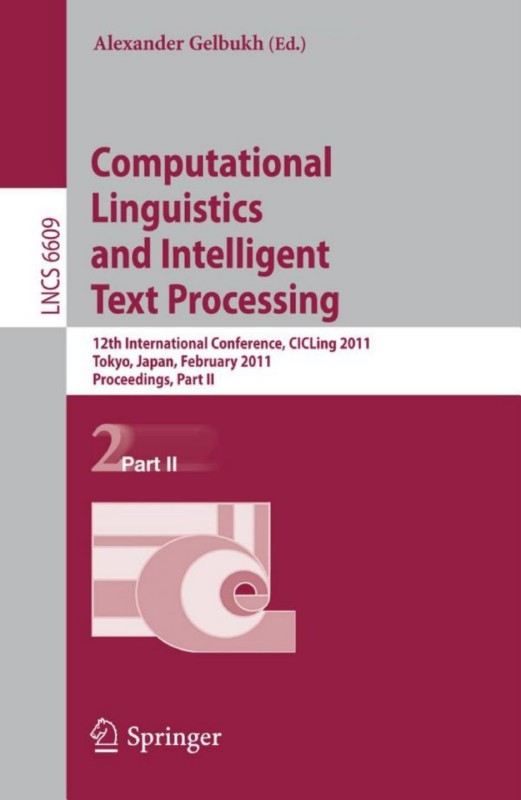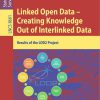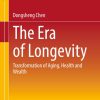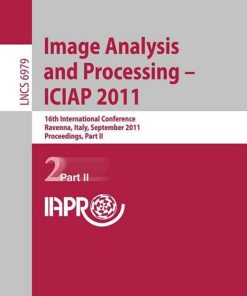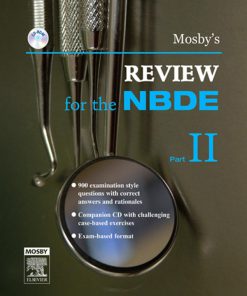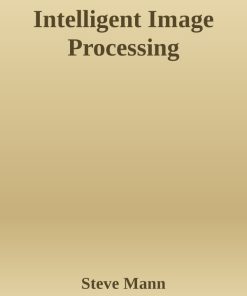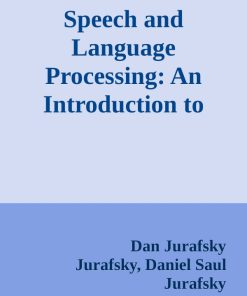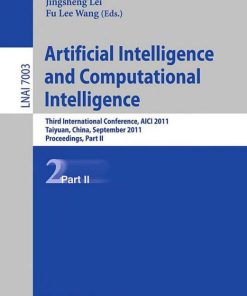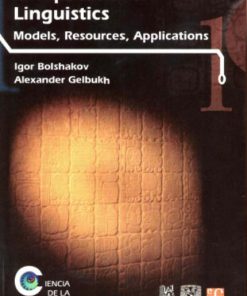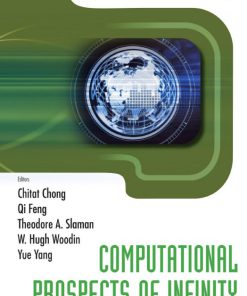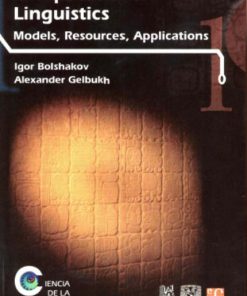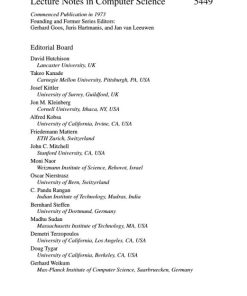Computational Linguistics and Intelligent Text Processing Part II 1st Edition by Alexander Gelbukh ISBN 3642549039 9783642549038
$50.00 Original price was: $50.00.$25.00Current price is: $25.00.
Authors:Alexander Gelbukh , Tags:Springer 2011 , Author sort:Gelbukh, Alexander , Ids:3642194362 , Languages:Languages:eng
Computational Linguistics and Intelligent Text Processing Part II 1st Edition by Alexander Gelbukh – Ebook PDF Instant Download/Delivery. 3642549039, 9783642549038
Full download Computational Linguistics and Intelligent Text Processing Part II 1st Edition after payment
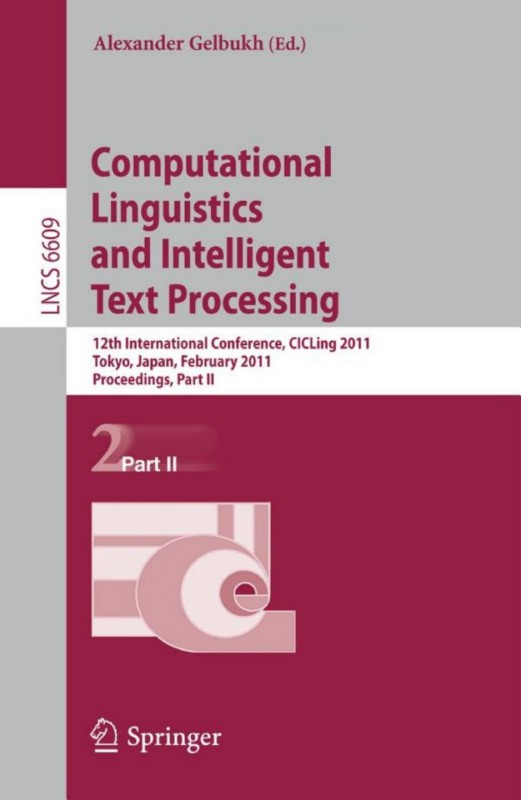
Product details:
ISBN 10: 3642549039
ISBN 13: 9783642549038
Author: Alexander Gelbukh
This two-volume set, consisting of LNCS 8403 and LNCS 8404, constitutes the thoroughly refereed proceedings of the 14th International Conference on Intelligent Text Processing and Computational Linguistics, CICLing 2014, held in Kathmandu, Nepal, in April 2014. The 85 revised papers presented together with 4 invited papers were carefully reviewed and selected from 300 submissions. The papers are organized in the following topical sections: lexical resources; document representation; morphology, POS-tagging, and named entity recognition; syntax and parsing; anaphora resolution; recognizing textual entailment; semantics and discourse; natural language generation; sentiment analysis and emotion recognition; opinion mining and social networks; machine translation and multilingualism; information retrieval; text classification and clustering; text summarization; plagiarism detection; style and spelling checking; speech processing; and applications.
Computational Linguistics and Intelligent Text Processing Part II 1st Table of contents:
1 Introduction
2 Related Work
2.1 Subjectivity Classification
2.2 Sentiment Classification
2.3 Sentiment Analysis on Special Sentences
3 Problem Statement
4 Linguistic Analysis of Modality
4.1 Mood
4.2 Modal Systems
5 Feature Construction
5.1 General Linguistic Features
5.2 Modality Features
6 Classification Strategy
6.1 Lexicon-Based Strategy
6.2 Standard SVM Classifier
6.3 Naive Bayes Strategy
6.4 Our Strategy
7 Experimental Evaluation
7.1 Data Sets
7.2 Experiment Results and Discussion
8 Conclusion and Future Work
References
Word-Level Emotion Recognition Using High-Level Features
1 Introduction
1.1 Background
2 Method
2.1 The AVEC2012 Challenge
2.2 Disfluency Features
2.3 The ASM Visual Features
2.4 Speaker Normalization
2.5 Modality Fusion and Feature Engineering
2.6 Regression and Evaluation Metric
3 Experiments and Results
3.1 The Disfluency Feature Model
3.2 The ASM Visual Feature Model
3.3 The Bimodal Models
4 Discussion
5 Conclusions
References
Constructing Context-Aware Sentiment Lexicons with an Asynchronous Game with a Purpose
1 Introduction
2 Related Work
3 Context Definition
4 Human Computation Task
4.1 Task Design
4.2 Gameplay
4.3 Scoring Mechanism
5 Quality Assurance
5.1 Tutorials
5.2 Answer Filtering
5.3 Answer Aggregation
6 Experiments and Results
6.1 Dataset
6.2 Worker Participation
6.3 Answer Usefulness Evaluation
6.4 Context-Dependent Lexicon Evaluation
7 Conclusions
References
Acknowledging Discourse Function for Sentiment Analysis
1 Introduction
2 Discourse Function
2.1 Expressive
2.2 Persuasive
3 Corpus
4 Method
5 Results and Discussion
6 Conclusion
References
A Method of Polarity Computation of Chinese Sentiment Words Based on Gaussian Distribution
1 Introduction
2 Related Works
3 Polarity Computation Method based on Gaussian Distribution
3.1 Definitions
3.2 Construction of Polarity Lexicon
3.3 Fundamental Sentiment Words Analysis
3.4 Compound Sentiment Words Analysis
4 Experiments
4.1 Performance of Fundamental Sentiment Word Analysis
4.2 Performance of Compound Sentiment Word Analysis
4.3 Analysis
5 Conclusions
References
A Sentence Vector Based Over-Sampling Method for Imbalanced Emotion Classification
1 Introduction
2 Related Works
3 Our Approach
3.1 Sentence Vector Representation Using Word/POS Vector
3.2 Sentence Vector Based Over-Sampling for Constructing Balanced Corpus
3.3 Training Classifier Using Balanced Data
4 Evaluation and Discussions
4.1 Experiment Setting
4.2 Evaluation on Balanced Training Data Construction
4.3 Evaluations on Emotion Classification
4.4 Error Analysis
5 Conclusion
References
Reader Emotion Prediction Using Concept and Concept Sequence Features in News Headlines
1 Introduction
2 Related Works
3 Our Approach
3.1 Concept Feature
3.2 Concept Sequence Feature
3.3 Reader Emotion Predication Using Multi-label Classifier
4 Evaluation and Discussion
4.1 Experiment Setting
4.2 Experimental Results and Discussions
5 Conclusion
References
Identifying the Targets of the Emotions Expressed in Health Forums
1 Introduction
2 Motivations and Task Definition
3 State of the Art
4 Initial Evaluations
5 Results
6 Conclusions and Perspectives
References
Investigating the Role of Emotion-Based Featuresin Author Gender Classification of Text
1 Introduction
2 Related Work
2.1 Gender Classification
2.2 Emotion Analysis
2.3 Emotion Expression as Features vs. Author’s Gender
3 Method
3.1 Emotions for Gender Classification
3.2 Ontology-Dependent Emotion Features
3.3 Ontology-Independent Emotion Features
4 Experimental Design
4.1 Datasets
4.2 Feature Value Assignments
4.3 Classifiers
5 Results
6 Discussion and Implications
7 Conclusion
References
Opinion Mining and Social Networks
A Review Corpus for Argumentation Analysis
1 Introduction
2 Related Work
3 Design of a Corpus for Argumentation Analysis
3.1 Balanced Sampling of Web User Reviews
3.2 Tailored Annotation Scheme for Argumentations
3.3 Annotation by Web Users and Review Experts
3.4 Standard Corpus Format and Tool Support
4 Analysis of Review Argumentation on the Corpus
4.1 The Impact of the Local Sentiment Distribution
4.2 The Impact of the Local Sentiment Flow
4.3 The Impact of the Local Sentiment regarding Product Features
5 Conclusion
References
Looking for Opinion in Land-Use Planning Corpora
1 Introduction
2 State-of-the-Art
3 Towards a Specialized Vocabulary of Opinion Related to Land-Use Planning
3.1 Overview
3.2 Construction of the Specialized Vocabulary of Opinion
3.3 Assigning Opinion Score to Documents
4 Experiments
4.1 Description of the Corpus
4.2 Results
4.3 Is the Opiland Approach Generic?
4.4 Opiland Approach vs Supervised Approaches
5 Conclusions and Future Work
References
Cross-Lingual Product Recommendation Using Collaborative Filtering with Translation Pairs
1 Introduction
2 Related Work
3 Recommendation System to Help Non-japanese Buyers
3.1 Formatting
4 Data
5 Experiment
5.1 Cross Validation of Translation Pairs
5.2 More Realistic Scenario
6 Results
7 Discussion
7.1 Cross Validation of Translation Pairs
7.2 More Realistic Scenario
8 Conclusion
References
Identifying a Demand Towards a Company in Consumer-Generated Media
1 Introduction
2 Related Work
3 Types of Demand Sentences
4 Our Model
4.1 Building a Demand Orientation Lexicon by Spin Model
4.2 Features
5 Experiments
5.1 Experiment 1: Identifying Sentence Type (i)
5.2 Experiment 2: Identifying Sentence Types (i)-(iv)
6 Conclusion
References
Standardizing Tweets with Character-Level Machine Translation
1 Introduction
2 Related Work
3 Dataset
3.1 Support Lexicons
3.2 Lexicon of Twitterese
3.3 Manually Annotated Tweets
4 Experiments and Results
4.1 CSMT Datasets
4.2 Lower and Upper Bounds
4.3 CSMT Extensions
4.4 Lexicon vs. Corpus Standardization
4.5 Lemmatization Experiment
5 Conclusions
References
#impressme: The Language of Motivation in User Generated Content
1 Introduction
2 Background and Related Work
3 Motivational Language Uses
4 Detecting Motivational Acts through Distant Supervision
5 Modeling Motivation
5.1 Data
5.2 Using Comments to Infer Motivation
5.3 Modeling Motivation and Results
6 Conclusion
References
Mining the Personal Interests of Microbloggers via Exploiting Wikipedia Knowledge
1 Introduction
2 Related Work
2.1 Most Related Research
2.2 Other Research Topics on Microblogging
2.3 Applications of Wikipedia
3 Semantic Spreading Model
3.1 Intuition
3.2 Speading Activation
3.3 Semantic Trigger Parameter
3.4 Micorblog Semantic Distribution
4 Interest Mining System
4.1 System Architecture
4.2 Case Study
5 Experiments
5.1 Dataset
5.2 Comparison Methods
5.3 Evaluation Metrics
5.4 Experimental Results
6 Conclusion
References
Website Community Mining from Query Logs with Two-Phase Clustering
1 Introduction
2 Website Community Mining
2.1 Data Representation
2.2 Website Community Mining with Two-Phase Clustering
3 Experiments
3.1 AOL Query Log Data
3.2 Data Preprocessing
3.3 Results and Discussions
4 Related Work
5 Conclusions
References
Extracting Social Events Based on Timeline and User Reliability Analysis on Twitter
1 Introduction
2 Related Work
3 Event Extraction Based on Temporal LDA Model and Reliable Users
3.1 Event Extraction Based on Temporal LDA Model
3.2 Reliable User Detection
3.3 Event Filtering Based on Reliable Users
4 Experiments
4.1 Experimental Set-Up
4.2 Results on Reliable User Detection
4.3 Results on Event Extraction
5 Conclusion
References
Machine Translation and Multilingualism
Beam-Width Adaptation for Hierarchical Phrase-Based Translation
1 Introduction
2 Measuring Span Quality
3 Beam-Width Adaptation Strategies
3.1 Cell Closure
3.2 Dynamic Beam-Width
4 Experiments
4.1 Basic Hiero Settings
4.2 Cell Closure
4.3 Dynamic Beam-Width
5 Conclusion and Future Work
References
Training Phrase-Based SMT without Explicit Word Alignment
1 Introduction
2 Inter-lingual Triggers
3 Training Phrase with Multivariate Mutual Information
3.1 Selecting Phrases in Terms of Their Size
4 How to Improve This Method?
4.1 Improving by Selecting the Best Phrases
4.2 Lexical Weights
5 Evaluation
6 Conclusion
References
Role of Paraphrases in PB-SMT
1 Introduction
2 Related Works
3 System Description
3.1 Paraphrase Extraction
3.2 Paraphrase Extraction Using Comparable Corpora
3.3 Paraphrase Expansion Using Context
4 Tools and Resources
5 Experiments and Results
6 Conclusions and Future Works
References
Inferring Paraphrases for a Highly Inflected Language from a Monolingual Corpus
1 Introduction
2 Related Work
3 Paraphrasing Technique
3.1 Training a Context Classifier
3.2 Feature Extraction
3.3 Evaluation of the Context Classifier
3.4 Deriving Paraphrases from a Monolingual Corpus
4 Using Paraphrases in Translation
5 Experimental Approach and Results
6 Conclusions
References
Improving Egyptian-to-English SMT by Mapping Egyptian into MSA
1 Introduction
2 Previous Work
3 Patterns of OOV and Methods for Candidate Suggestions
3.1 Substring Repetition
3.2 Compounding Errors
3.3 Spelling Differences
3.4 Dialect-Based Errors and True OOVs
4 Model
4.1 Egyptian-to-MSA Decoder
4.2 Overall Model
5 Results
6 Mapping Egyptian to MSA through Pivoting
7 Conclusion
References
Bilingually Learning Word Senses for Translation
1 Introduction
2 Related Work
3 Approach Outline
3.1 Selection of Word Senses
3.2 Features Extraction
3.3 Features Correlation
3.4 Clusters Construction
4 Experiments and Results
4.1 Clusters Evaluation
4.2 Classifier
4.3 Classifier Results
5 Conclusions and Future Work
References
Iterative Bilingual Lexicon Extraction from Comparable Corpora with Topical and Contextual Knowledge
1 Introduction
2 Related Work
2.1 Topic Model Based Methods (TMBM)
2.2 Context Based Methods (CBM)
3 Proposed Method
3.1 Topic Model Based Method (TMBM)
3.2 Context Based Method (CBM)
3.3 Combination
4 Experiments
4.1 Experimental Data
4.2 Experimental Settings
4.3 Evaluation Criterion
4.4 Results
5 Discussion
5.1 Why Are Our “Topic” Scores Lower Than [4]?
5.2 How Does the Proposed Method Perform on Different Language Pairs?
5.3 How Many Iterations Are Required?
5.4 How Does the Number of Topics Affect the Performance?
5.5 How Does the Number of Candidates Affect the Performance?
5.6 What Kind of Lexicons Are Improved?
5.7 What Kind of Errors Are Made?
6 Conclusion and Future Work
References
Improving Bilingual Lexicon Extraction from Comparable Corpora Using Window-Based and Syntax-Based M
1 Introduction
2 Standard Approach
3 Context Representation
3.1 Window-Based Model
3.2 Syntax-Based Model
4 Combination Approach
4.1 Post Combination Approach
4.2 Prior Combination Approach
5 Linguistic Resources
5.1 Comparable Corpora
5.2 Bilingual Seed Lexicon
5.3 Evaluation Lists
5.4 Dependency Relation Parser
6 Experiments and Results
6.1 Experimental Setup
6.2 Results
7 Conclusion
References
An IR-Based Strategy for Supporting Chinese-Portuguese Translation Services in Off-line Mode
1 Introduction
2 Chinese-Portuguese On-line Translation Services
2.1 Chinese-Portuguese Translation System
2.2 Chinese-Portuguese Translation App
3 Off-line Search-Based Translation System
3.1 Search Engine for Translation
3.2 Contextualized Translation Services
4 Conclusions and Future Work
References
Cross Lingual Snippet Generation Using Snippet Translation System
1 Introduction
2 Related Work
3 The System Architecture
3.1 CLIA System
3.2 Snippet Translation Module
4 Snippet Generation
4.1 Key Term Extraction
4.2 Sentence Extraction
4.3 Top Sentence Identification
4.4 Snippet Unit Selection
4.5 Snippet Generation
5 Snippet Translation
5.1 Phrase-Based SMT
5.2 Snippet Translation Using PB-SMT
6 Experiments
6.1 Tools and Resources
6.2 Experimental Setup
7 Evaluation
8 Conclusions and Future Work
References
A Novel Machine Translation Method for Learning Chinese as a Foreign Language
1 Introduction
2 The Aggregated Language Model
3 Cue and Its Usage in Machine Translation
3.1 Translation as Cross-linguistic Cue Switching
3.2 Cues in Statistical Machine Translation Techniques
3.3 Cues in Example-Based Machine Translation Techniques
3.4 Cues in Rule-Based Machine Translation Techniques
3.5 Cues in Inter-lingual Machine Translation Techniques
4 Blending Cue-Switching Translation with Existing Techniques
5 A Computer-Aided Tool for German Speakers to Learn Chinese
6 Summary and On-going Work
References
Information Retrieval
A New Relevance Feedback Algorithm Based on Vector Space Basis Change
1 Introduction
2 Related Work
2.1 Relevance Feedback
2.2 Vector Space Basis Change
3 Vector Space Basis Properties
4 Optimal Transition Matrix and Relevance Feedback
4.1 Optimal Transition Matrix Identification
4.2 Relevance Feedback
5 Experiments
5.1 Environnement
5.2 Results
6 Conclusion
References
How Complementary Are Different Information Retrieval Techniques? A Study in Biomedicine Domain
1 Introduction
2 Dataset and Measures
3 Experiment
3.1 Impacts of Relevancy and Its Levels
3.2 What Happened?
3.3 Amounts of Relevant Passages Lost
3.4 Amounts of Aspects Lost
4 Discussion
5 Conclusion
References
Performance of Turkish Information Retrieval: Evaluating the Impact of Linguistic Parameters and Com
1 Introduction
2 Turkish Information Retrieval
3 Experimental Setup and Results
3.1 Milliyet Collection
3.2 Terrier IR System and Evaluation Measures
3.3 Baseline and Stop Words List Results
3.4 Documents and Queries Structure
3.5 Truncation Results
3.6 Stemming Results
3.7 Compound Nouns Results
4 Discussion of Results and Perspectives
References
Text Classification and Clustering
How Document Properties Affect Document Relatedness Measures
1 Introduction
2 Related Work
3 Methodology
3.1 Dataset Sources
3.2 Document Relatedness Models
4 Results and Evaluations
4.1 kNN-Classification Set-up
4.2 Document Attribute Values
4.3 Results and Discussion
4.4 Limitations
5 Conclusion
References
Multi-attribute Classification of Text Documents as a Tool for Ranking and Categorization of Educa
1 Introduction
2 Description of a New Classification Method
2.1 Overview of the Mission Indicators
2.2 Data Collection from Text Documentation
2.3 Text Classification and a New EIP Classification Method
3 Classification of the IEPs: An Illustrative Example
4 Conclusion
References
Named Entities as New Features for Czech Document Classification
1 Introduction
2 Related Work
3 Document Classification with Named Entities
3.1 Preprocessing, Feature Selection and Classification
3.2 Named Entity Integration
4 Experiments
4.1 Tools and Corpora
4.2 Analysis of the Named Entity Distribution According to the Document Classes and Classification w
4.3 Classification Results of the Proposed Approaches
4.4 Analysis of the Confusion Matrices
5 Conclusions and Future Work
References
A Knowledge-Poor Approach to Turkish Text Categorization
1 Introduction
2 Related Works
3 Feature Space
3.1 Feature Selection Criteria
3.2 Term Weighting Schema
4 Experimental Setup
4.1 Data
4.2 Classification
5 Results and Evaluation
5.1 Performance of Feature Selection Methodology
5.2 Cross-Classifier Comparison
5.3 Evaluation of Term Weighting
5.4 Evaluation of Feature Selection Size
5.5 Impact of Document Frequency on Accuracy
6 Conclusion
References
Credible or Incredible? Dissecting Urban Legends
1 Introduction
2 Related Work
3 Datasets
4 Feature Extraction
5 Descriptive Statistics
6 Classification Experiments
7 Discussion
8 Conclusions
References
Intelligent Clustering Scheme for Log Data Streams
1 Introduction
2 Related Literature
3 Log Clustering Scheme
3.1 Signature Generation
3.2 Similarity Search
4 Results and Discussion
4.1 Test Data Set
4.2 Clustering and Validation of Labeled Datasets
4.3 Clustering and Validation of Unlabeled Datasets
5 Conclusion
References
Text Summarization
Graph Ranking on Maximal Frequent Sequences for Single Extractive Text Summarization
1 Introduction
2 Graph-Based Algorithm
2.1 Text Representation Using Graphs
2.2 Graph-Ranking Algorithms
3 Maximal Frequent Sequences
4 Proposed Method
5 Experimental Setting and Results
6 Future Work
References
Plagiarism Detection
A Graph Based Automatic Plagiarism Detection Technique to Handle Artificial Word Reorderingand Parap
1 Introduction
2 Problem Statements and Motivation
3 Literature Survey
4 Normalized PMI Score
5 Word Graph Construction
5.1 Input Cleaning and Pre-processing
5.2 Preparing Word Graph of Text
6 Calculating Controlled Closeness Centrality Score
7 Using Minimum Weight Bipartite Graph Clique Covering
8 Extracting Plagiarized Texts
9 Pseudo Code
10 Evaluation
10.1 Systems Used in Evaluation and Evaluation Metrics
10.2 Analysis of Result
11 Conclusion and Future Scope
References
Identification of Plagiarism Using Syntactic and Semantic Filters
1 Introduction
2 Our Approach
2.1 Retrieval of Probable Plagiarized Passages
2.2 Filtering of Plagiarized Passages based on Syntactic Rules and Lexical Semantics
3 Experiments and Results
4 Conclusion and Future Work
References
Style and Spelling Checking
Readability Classification of Bangla Texts
1 Introduction
2 Related Work
3 Corpus
4 Features
4.1 Lexical Features
4.2 Information-Theoretic Features
5 Experiments
5.1 A Baseline Classifier
5.2 A Classifier Based on Lexical Features
5.3 A Classifier Using Entropy-Related Features
5.4 A Classifier Based on Information Transmission-Related Features
6 Discussion
7 Conclusion
References
State-of-the-Art in Weighted Finite-State Spell-Checking
1 Introduction
1.1 A Brief History of Automatic Spell-Checking and Correction
1.2 Notations and Some Statistics for Language and Error Models
1.3 Morphologically Complex Resource-Poor Languages
2 Weighting Finite-State Language and Error Models
2.1 Compiling Finite-State Language Models
2.2 Compiling Finite-State Versions of Error Models
2.3 Combining Weights from Different Sources and Different Models
3 The Language and Error Model Data Used for Evaluation
3.1 The Models Used for Evaluation
4 The Speed and Quality of Different Finite-State Models and Weighting Schemes
4.1 Coverage Evaluation
4.2 Quality Evaluation
4.3 Speed Evaluation
4.4 Memory Usage Evaluation
5 Discussion
6 Conclusion
References
Spelling Correction for Kazakh
1 Introduction
1.1 Our Contribution
2 Related Work
3 Methodology
4 Experiments and Evaluation
5 Conclusion and Future Work
References
Speech Processing
A Preliminary Study on the VOT Patterns of the Assamese Language and Its Nalbaria Variety
1 Introduction
2 Literature Review
3 Experimental Framework
3.1 Speech Corpus
3.2 Measuring VOT
3.3 Methodology/Acoustic Measurements
3.4 Results
4 Conclusion and Future Work
References
Applications
Evaluation of Sentence Compression Techniques against Human Performance
1 Introduction
2 Sentence Compression Techniques
2.1 Syntactic Pruning
2.2 Machine Learning Techniques
2.3 Hybrid Methods
2.4 Keyword/Phrase Based Techniques
2.5 Human Compressed Summaries
2.6 Human Compression Rate
2.7 Content Evaluation Using ROUGE
2.8 Content Evaluation Based on Grammatical Relations
3 Discussion
4 Conclusion and Future Work
References
Automatically Assessing Children’s Writing Skills Based on Age-Supervised Datasets
1 Introduction
2 Predicting Children’s Age from Text
2.1 A “Toy-Study”
2.2 Regression for Age Prediction
3 Experimental Evaluation
3.1 Datasets
3.2 Features
3.3 Regression Models
3.4 Results
3.5 Some Examples
4 Discussion
5 Conclusion
People also search for Computational Linguistics and Intelligent Text Processing Part II 1st:
computational linguistics and intelligent text processing
conference on intelligent text processing and computational linguistics
is computational linguistics hard
what is computational linguistics
difference between computational linguistics and natural language processing

